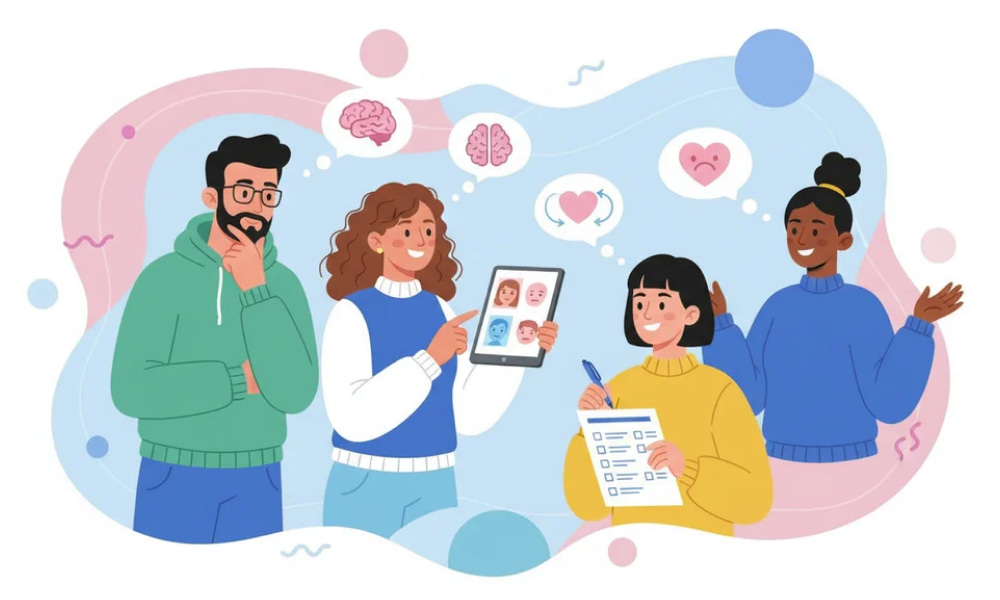Quick Emotional Intelligence Quiz: Measure Your EQ Online
New Updates



Take Emotional Intelligence Test Online
Start the Test →Online Emotional Intelligence Test: the Key to Better Relationships & Success
Emotional intelligence describes how we perceive, interpret, and use feelings to navigate decisions, relationships, and complex situations. It blends self-awareness, empathy, emotional regulation, and social skills into a practical capability you can improve through intentional practice. Unlike personality, which is relatively stable, this capability shifts with coaching, reflection, and structured feedback, making it worth measuring with care. Reliable assessment elevates awareness from abstract ideas to concrete insight, revealing strengths you can leverage and blind spots you can address.
Assessments bring structure to introspection by translating nuanced behaviors into interpretable data. In practice, many newcomers start with an emotional intelligence test to establish a reliable baseline for growth. Robust scoring and clear report narratives help you move beyond vague labels toward targeted action plans. With the right tool, subtle patterns become visible, and tangible next steps naturally emerge.
Curiosity often begins with approachable resources that make the topic feel less intimidating. For lighter engagement, a socially friendly emotional intelligence quiz can spark curiosity before deeper evaluation. As interest matures, people typically transition to more rigorous instruments designed to minimize bias and improve decision-making in real-world settings.

Emotional Intelligence Appraisal Test: Your Key to Success
Clarity about emotions pays off in every domain where human interaction matters. Team dynamics stabilize when people can detect tension early and respond thoughtfully rather than reactively. Leaders who listen with precision and regulate stress under pressure build trust, reduce friction, and drive better results. Relationships outside of work also benefit as you learn to read context, name feelings accurately, and meet needs without escalation.
- Sharper communication: say what you mean without creating unintended conflict.
- Better collaboration: align diverse perspectives into shared commitments.
- Resilience under pressure: keep your thinking flexible when the stakes are high.
- Customer empathy: anticipate concerns and tailor responses in real time.
- Sustainable leadership: cultivate psychological safety and accountability together.
Not every situation requires a long evaluation or elaborate debrief. When efficiency matters, a compact EQ test still flags trends you can validate with more rigorous tools. Short formats create momentum by lowering the barrier to starting, and they help organizations scale development initiatives quickly.
Some contexts demand a more structured, job-relevant evaluation to drive concrete behavior change. For leadership pipelines, a structured emotional intelligence appraisal test aligns development plans with measurable behaviors. These results inform coaching priorities, succession decisions, and targeted learning paths that create compound benefits across teams.
Major EI Assessment Approaches and How They Compare
Different instruments rest on different theories, and knowing the distinctions helps you select the right tool for your purpose. Ability-based measures use performance tasks to evaluate how accurately people work with emotional information across scenarios. Among ability-based measures, the well-researched MSCEIT evaluates how accurately people perceive, use, understand, and manage emotions. Self-report inventories, by contrast, gather your self-perceptions, which can be very informative when paired with multi-rater feedback that checks for blind spots.
| Assessment Type | Approach | Typical Time | Best Use |
|---|---|---|---|
| Ability-based measure | Performance tasks scored by consensus or experts | 30–45 minutes | Objective insight into emotional reasoning skills |
| Self-report inventory | Ratings of your typical behaviors and preferences | 10–25 minutes | Quick screening and personal reflection |
| 360-degree feedback | Self plus peer/manager/direct-report ratings | 20–40 minutes | Development for leadership and team impact |
| Situational judgment | Vignettes with ranked choices for best responses | 15–30 minutes | Hiring and promotion decisions with context |
| Micro-assessments | Short pulses embedded in learning journeys | 5–10 minutes | Habit building and ongoing progress checks |
Ability-based tools estimate skill through tasks rather than opinions, which can be powerful when you need objective evidence. Within the ability tradition, the Mayer-Salovey-Caruso emotional intelligence test remains notable for its consensus and expert-scored items. For group programs, that structure provides comparable benchmarks you can track over time.
No single method captures every nuance of how emotions shape performance across contexts. Self-report inventories, by contrast, depend on accurate self-insight and social desirability controls. Researchers strengthen validity by triangulating results across multiple psychometric tests emotional intelligence approaches, and 360-degree feedback. Combining perspectives creates a richer, more trustworthy picture of day-to-day behavior. Public awareness of EI surged with accessible writing and leadership-focused frameworks that translated research into practice. Many managers are introduced to the topic through the accessible Daniel Goleman emotional intelligence quiz, which emphasizes practical workplace competencies. Over time, those entry points often lead to deeper methods that support evidence-based development.
How to Choose, Prepare For, and Take an EI Assessment
Good selection starts with a clear purpose: hiring, promotion, coaching, or personal growth. Consider the tradeoffs among objectivity, time, and depth, and decide how results will be used in real decisions. For individual development, it helps to combine assessment with learning sprints, reflection prompts, and consistent practice. If the budget is tight, a reputable free emotional intelligence test can still surface directional insights to guide practice.
Set yourself up for accuracy by choosing a quiet environment and answering steadily rather than overthinking each item. When time is scarce, a well-designed quick emotional intelligence test offers a snapshot without overwhelming you with jargon. Immediately after completing an instrument, write down two observations and one action you can try within the next week. Ratings are most valuable when they are honest, consistent, and grounded in real behavior. Before committing to coaching, many learners sample an emotional intelligence test free to gauge fit and relevance. If you’re using a multi-rater format, invite reviewers who have observed you in calm and high-pressure moments for a balanced view.
- Clarify your goal: selection, development, or benchmarking.
- Choose a format that matches your timeline and depth needs.
- Take it in one sitting, free from distraction or time pressure.
- Capture immediate insights while your memory is fresh.
- Translate results into two habits you can practice this week.
Progress compounds when assessment and practice reinforce each other over time. To build momentum, set a 30-minute calendar block each month to test your emotional intelligence and document small wins. Small, repeatable changes accumulate into tangible improvements in clarity, composure, and connection.

Interpreting Scores, Tracking Progress, and Using Online Tools
Numbers are only the beginning; meaning comes from context and follow-through. High scores in perception don’t automatically translate into better outcomes if regulation or empathy lags. Look for patterns across subscales, not just the overall index, and anchor interpretations in situations you actually face at work or home. For convenience, curated platforms host an emotional intelligence test free online alongside guided learning paths and progress tracking. Don’t read results as immutable traits; treat them as a snapshot that guides deliberate practice. Remote teams often standardize on an EQ test online to keep assessment logistics simple across time zones. After you review your profile, identify a single scenario, such as difficult feedback or negotiation, where you can test one new strategy.
Adopt a rhythm where brief measurement cycles spur timely reflection and incremental upgrades. Early-stage programs sometimes start with a vetted free emotional intelligence test online to lower barriers while building engagement. Over quarters, the combination of repeated assessment and purposeful experimentation creates durable skill gains that show up in collaboration, leadership, and customer outcomes.
- Focus on two subscales at a time to avoid dilution of effort.
- Pair insights with micro-habits you can anchor to daily routines.
- Review progress monthly and recalibrate goals using fresh data.
- Invite feedback from trusted peers to validate real-world change.
- Celebrate small wins to sustain motivation and consistency.
Take Emotional Intelligence Test Online
Start the Test →Frequently Asked Questions
-
How accurate are EI assessments compared to other measures?
Accuracy depends on the instrument’s design and how results are interpreted in context. Ability-based measures can reduce bias by scoring performance on emotion-related tasks, while self-report formats provide a valuable perspective when paired with outside feedback. The most dependable insights appear when multiple data sources converge on the same patterns.
-
Can EI be improved, or is it fixed like personality?
EI develops with practice, coaching, and reflective routines that build awareness and regulation. Because it involves learnable skills, structured plans, and regular feedback loops lead to measurable improvement over time. Even small, consistent exercises, like naming emotions under stress, produce meaningful gains.
-
Which assessment type is best for hiring decisions?
For selection, organizations often prefer approaches that minimize self-report bias and focus on observable behavior. Situational judgment and multi-rater inputs complement interviews by highlighting how candidates respond in realistic scenarios. Calibration across roles and validated scoring rubrics further strengthens fairness.
-
How often should I retest to track progress?
Quarterly or biannual cycles work well for most people because they balance reflection with real opportunities to apply new habits. Too-frequent testing can create noise, while long gaps make it hard to attribute changes to specific actions. Match the cadence to your coaching plan and the complexity of your goals.
-
What should I do right after receiving my report?
Start by summarizing the top two strengths and one priority growth area, and link each to a real scenario you face. Draft one experiment you will try in the next week, then ask a colleague to observe and give feedback. Conclude by scheduling your next review to convert intention into a sustainable routine.
 Comprehensive Guide to Ability-Based Emotional Intelligence Measurement
Comprehensive Guide to Ability-Based Emotional Intelligence Measurement